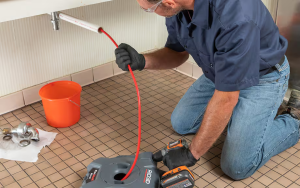While gutters are often overlooked, they play an important role in protecting a home. They are responsible for directing rainwater away from the house, preventing roof leaks, foundation damage, and mildew growth.
Gutters are designed with a slight slope to channel water down towards the downspouts and into an underground drainage system. However, they can easily become clogged with debris. Click the https://guttercleaningcharlestonsc.com/ to learn more.

Gutters may seem simple at first glance, but they play a crucial role in protecting your roof, walls, windows, foundation, landscaping, and basement from excess moisture. They help direct rainwater away from the house, and they keep water flowing swiftly so that moisture doesn’t cause rot, mold, or other problems. Gutters are designed to be installed at a slight downward slope to allow water to flow freely into downspouts or drains. Regular maintenance is critical to ensure that your gutter system is free of debris and properly functioning.
The first step in a successful gutter installation project is to select and purchase the proper materials. You’ll need gutter sections (typically aluminum or vinyl), fascia bracket hangers, screws and rivets, a ladder, and a level.
Once you’ve selected your gutter section, measure your roofline to determine the length of gutter needed. Allow for a couple of extra feet to account for overhangs and corners. Next, mark a chalk line along the roofline to indicate the gutter run angle and placement. You should aim for a slope of 1/4 inch for every 10 feet of gutter to allow for optimal drainage.
Next, fasten the gutter hangers to the rafter tails with 1/4-inch stainless steel lag screws long enough to penetrate the wood 2 inches. Rub the heads of these screws with soap before driving them to make it easier to drive them through the fascia and into the rafters. If your gutter runs around a corner, cut the appropriate angle on that end, typically 45 degrees.
Finally, secure each gutter section to the fascia brackets with screw or rivet (depending on your chosen method). If you’re using a screw, use a self-tapping screw that is a good match for your gutter material, and install a washer between the screw head and the rafter tail. If you’re using a pop rivet, seal the end cap seam and any other openings with a high-quality siliconized caulk.
Once the gutters are in place, connect downspouts to each gutter section with gutter elbows or extensions and screw a downspout outlet into the bottom of each downspout. Finally, install end caps on each end of the gutter section to seal the ends of the gutters.
Pitch
Gutter slope, also known as gutter pitch, is the downward slant that your gutters should have to manage water flow. It is important for the overall efficacy of your gutters and protects your home from long-term damage. It can be difficult to determine the proper gutter slope for your home and may require the help of a professional. However, it is possible to spot some common signs that your gutters aren’t slanted correctly. Standing water or clogged gutters are both good indicators that your gutters are not pitched properly.
A correctly pitched gutter allows water to flow freely and naturally downhill into the downspouts. Gutter pitch should be measured using a level and should be approximately 1/4 inch for every 10 feet (3 metres) of gutter length. This is the ideal pitch for most homes, although some regions may benefit from a steeper gutter slope to handle higher rainfall intensity.
If your gutters are not pitched at all or if the pitch is too steep, then you will end up with water that pools in the gutter rather than flowing downhill to the downspouts. This can lead to the rusting of gutters and a number of other issues. A gutter that is pitched too low, on the other hand, can cause water to rush over the sides of your gutters and into your house. This can lead to water damage and mold.
You may have heard the term “in the gutter” in a figurative sense when someone talks about having sexy thoughts or thinking crudely. However, the phrase is used literally as well when referring to a person dying in the gutter of a city street. This is a sad and often hopeless way to die and many people do not want to be remembered in this manner.
Downspouts
Gutters and downspouts are essential to your home’s drainage system. They’re a crucial component to preventing costly water damage from heavy rain and melting snow. They channel water away from your foundation, protecting the structure of your house and avoiding flooding and structural damage.
Downspouts are a pipe attachment that runs from the gutter to the ground, directing the flow of water. They come in a wide variety of sizes and shapes to accommodate different roof types, houses, and landscapes. They’re also available in a wide array of colors and styles to complement the overall look of your gutter system and home.
Gutter downspouts are typically made of the same material as the gutter system they’re connected to. Copper gutter systems will often feature copper downspouts, and aluminum gutters will be paired with aluminum downspouts. In some cases, you can even have custom downspouts made for your specific gutter system.
One of the most important aspects of a good gutter is its design. A well-designed gutter downspout is angled so that the water can flow downhill, and it’s designed to be as low-profile as possible. This helps to prevent the downspout from collecting debris and clogging.
A good downspout should be a minimum of 3 feet long, and you can increase the length as needed based on the size of your property and its surrounding environment. If the downspout is too short, it won’t be able to drain the built-up water away from your house properly.
If your gutter downspouts are causing problems like pooling water or creating no-swim zones around the foundation of your home, you can install gutter downspout extensions to help prevent these issues. These are easy to install and can be done for a relatively inexpensive price.
You can also use a downspout extension to help you collect rainwater for reuse in your garden or yard. This is an eco-friendly option and is a great way to conserve water during periods of drought or inclement weather. It’s a simple and affordable option that can make a big difference in your yard’s ability to survive in the face of extreme weather conditions.
Maintenance
Gutter maintenance is an important part of home maintenance that keeps your roof, siding, foundation and landscaping safe from water damage. It’s also one of the easiest things that homeowners can do to protect their home from costly repairs and maintain its value.
Gutters are designed to swiftly remove rainwater and direct it away from the home’s foundation and walls. If they are clogged with leaves, twigs and debris, the flow of water becomes disrupted and the gutter can overflow. This water can cause water damage to the roofing, walls and interior of your home.
Regular gutter cleanings can avoid this water-related damage by ensuring that the system works as intended. This includes checking for any issues like cracks, rust or loose fasteners. Gutter cleaning is usually done twice a year, in spring and autumn, but it may need to be done more often depending on the area where you live.
During the cleaning process, you should use a ladder that is in good condition and be sure to work safely. If you aren’t comfortable working on a ladder, it’s best to hire a professional. Start by removing all of the debris from the gutters using a garden trowel or scoop. Then, move on to the downspouts and check for clogs. If you see a clog, use the trowel to dislodge it and then flush out the gutter with a hose.
Gutters can be made from different materials, including aluminum, steel and copper. Aluminum is popular because it is lightweight and rust-resistant. Steel is more durable but is heavier and can rust over time. Copper is a beautiful material that has many advantages, but it’s expensive and more difficult to install than aluminum or steel.
Taking the time to clean and inspect your gutters can prevent water damage, soil erosion and basement flooding, which can cost thousands of dollars in repairs. With proper care, your gutters can last a lifetime. If you have any questions about your gutters, don’t hesitate to contact us for a free consultation. We’ll help you select the right gutters and downspouts for your home, install them correctly, and protect it from water damage.








